#kalamkari fabrics
Explore tagged Tumblr posts
Text
Gandhigram Trust’s Samhita products on sale
#Gandhigram Trust’s Samhita products on sale #events #News
Gandhigram Trust’s Samhita products on sale Gandhi-Khadi_Naturals ~ Customers can buy contemporary Khadi readymade apparel, handmade block printed sarees, food items, personal care and home care products Gandhigram Trust is organising an exhibition of their Khadi readymade clothing range – Samhita – on the 6th and 7th of September, 2024 at CP Arts Centre, Eldams Road, Chennai from 10 am…
#Adambakkam News#Adambakkam Times#Alwarpet Times#Arcot road talk#Arts#Ashok Nagar News#Ashok Nagar Times#Chennai#Chennai News#Chennai times#Chennaiites#chennaites#chrompet news#Chrompet Times#ECR News#Ecr Times#entertainment#events#fabrics#Gandhigram Trust#Gandhigram Trust’s Samhita products#Gandhiji#hand-block printed towels#IndiGo#Kalamkari fabrics#Khadi#Kilpauk News#Kilpauk Times#Kodambakkam News#Kotturpuram Times
0 notes
Text
Explore the Beauty of Jacquard Fabric Material at iTokri
Discover the exquisite elegance of jacquard fabric material at iTokri. Our collection showcases intricate patterns and high-quality craftsmanship, perfect for creating stylish garments and home decor. Jacquard fabric is known for its durability and luxurious texture, making it a favorite among designers and fashion enthusiasts. Shop now to find unique designs that elevate your style and add a touch of sophistication to your wardrobe or living space.
#jacquard fabric material#bandhani fabrics#bandhani dress material#kalamkari fabrics#Eco-friendly Artisan Products
0 notes
Text
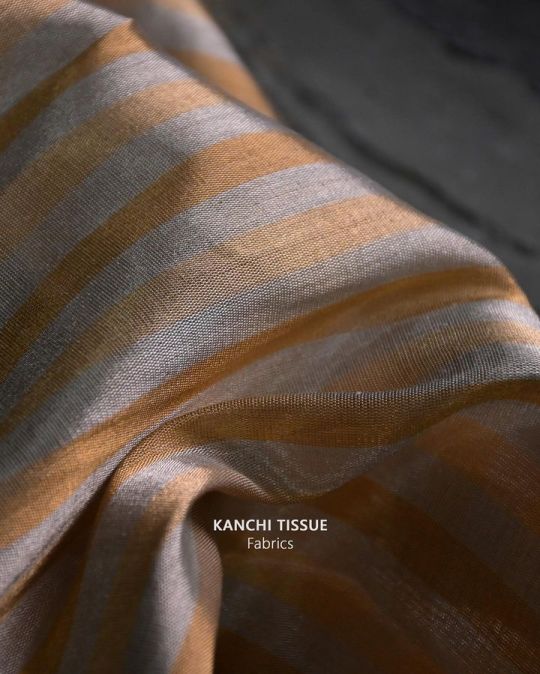
Kanchi Tissue Fabric caresses you in tenderness. Show yourself some grace and stay solidly grounded. To contact Fabric by Singhania's, please visit the website www.fabricbysinghanias.com or Whatsapp on 9063253310. Follow Fabric by Singhania's on Instagram @fabrics_singhanias for the latest Fabrics
#kanchitissuefabric#georgette fabric#crepe fabric#organza fabric#chiffon fabrics#cottony fabric#chiffon fabric#kalamkari fabrics
0 notes
Text
Discover Trendy Kalamkari Fabric Designs Online: Stylish & Fashionable Options
Explore a wide range of Kalamkari Fabric designs online. Find stylish and fashionable options, including designer kalamkari fabric, kalamkari cloth material, kalamkari material for ladies. For More: https://www.luxurionworld.com/collections/kalamkari-fabrics
#kalamkari fabric#kalamkari cloth material#kalamkari material#kalamkari silk fabric#kalamkari fabric online
0 notes
Text
Unveil the Elegance: Kalamkari Silk
Introduction
India is home to a multitude of captivating art forms and Kalamkari stands out among them. The name itself comes from combining two words - "Kalam," meaning pen, and "Kari," which translates to craft. In this art form, skilled artists use a wooden pen to draw intricate designs on fabric. Kalamkari Sarees are some of the most renowned creations, highlighting the art's beauty. What makes the process even more special is that no machines are used; everything, from treating the fabric to adorning it with designs, is done by hand. This meticulous craftsmanship means it takes several days to complete just one saree.

Originating in the southern state of Andhra Pradesh, Kalamkari boasts a rich history dating back at least 3000 years. Passed down through generations, craftsmen dedicated their lives to honing and perfecting this art, shaping it into what it is today. The primary hubs for Kalamkari Silk Sarees are Machilipatnam and Srikalahasti, each with slightly different processes. In Srikalahasti, artists use wooden pens to outline designs, while in Machilipatnam: hand-carved wooden blocks are employed to print outlines. The result is breathtaking patterns featuring flowers, vines, trees, peacocks, parrots, and more, meticulously crafted on cotton and silk fabrics using natural dyes.
Types of Kalamkari
Srikalahasti Style: Freehand Drawing: Originating from the town of Srikalahasti in Andhra Pradesh, this style involves freehand drawing using a pointed bamboo or date palm stick. Natural Dyes: Artists use natural dyes extracted from plants, minerals, and other organic sources, creating a vibrant and earthy color palette. Religious Themes: Srikalahasti Kalamkari often depicts mythological or religious themes, showcasing intricate details and elaborates storytelling.
Machilipatnam Style: Block Printing: Hailing from Machilipatnam in Andhra Pradesh, this style involves block printing with hand-carved wooden blocks. Persian Influence: Introduced during the Golconda Sultanate, the Persian influence is evident in the floral and geometric patterns found in machilipatnam kalamkari sarees. Use of Mordants: Artists use Mordants to fix the dyes, allowing for a range of colors and intricate designs. The process involves multiple stages of dyeing and washing.
Both styles showcase the mastery of skilled artisans and reflect the rich cultural heritage of India. While Srikalahasti Kalamkari emphasizes freehand drawing and natural dyes, Machilipatnam Kalamkari excels in block printing and intricate Persian-inspired designs. Each type tells a unique story through its artistry, making kalamkari cotton sarees a cherished and timeless form of textile decoration.
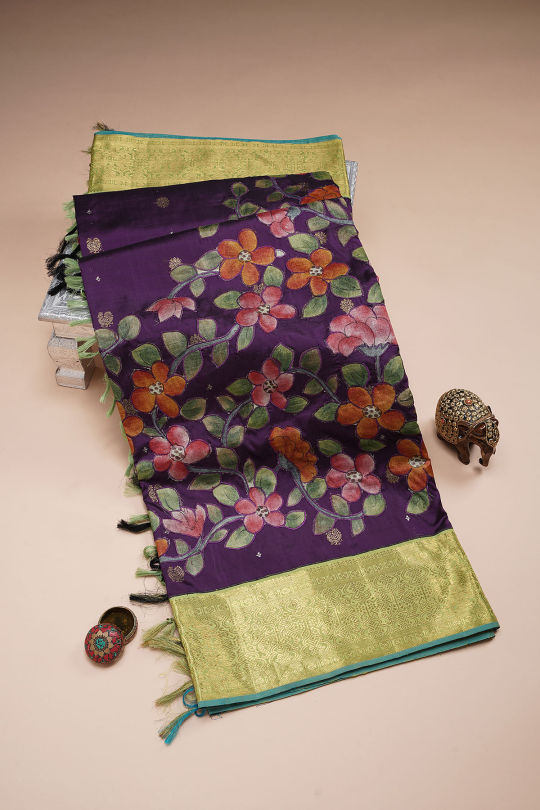
Lets know about Kalamkari Silk
The sublime allure of kalamkari designs saree graces silk fabric, infusing it with opulence and enhancing the overall aesthetic. These intricate patterns, often referred to as Original Kalamkari Saree painting designs, depict divine themes such as temples and gods, lending a sacred touch to the garments. The unique perspective, resembling a celestial viewpoint, imparts an ethereal quality to kalamkari silk sarees for wedding, where each fold echoes tales viewed from heavenly realms.
Step into the world of Pure Kalamkari Silk Sarees, where artists carefully paint pretty designs on soft fabric with bright colors. These Sarees share stories through beautiful patterns inspired by myths, nature, and history. They've been around for a really long time, and people love them for how they mix art and style. You can discover how to wear them for different events and occasions. Kalamkari Sarees Silk are extra special because each one is handcrafted and unique. So, if you like the idea of wearing something that tells a story and looks beautiful, kalamkari silk sarees online might be just what you're looking for!
Discover the epitome of style with our exclusive collection of designer Kalamkari outfits. Our trendy Kalamkari Sarees, available online, showcase the finest craftsmanship in Kalamkari cotton Sarees. We take pride in offering the best Kalamkari Sarees with the latest designs, ensuring you stay ahead in fashion. Explore our range to find the latest designs in Kalamkari Sarees, each one an original piece of hand-painted artistry. Immerse yourself in the rich tradition and authenticity of Kalamkari with our latest collections of Kalamkari cotton Sarees. Elevate your wardrobe with these timeless pieces that seamlessly blend tradition and contemporary style.

Major Things to See While Buying Kalamkari Saree
Authenticity: Look for genuine authentic kalamkari sarees, traditionally made using the natural dyeing process. Avoid machine-printed imitations that lack the intricate detail and unique color palette of hand-painted or block print kalamkari designs.
Quality of fabric: Opt for Sarees made with high-quality, natural fabrics like cotton or silk. These materials are not only comfortable but also allow the intricate designs and colors to shine through. Avoid Sarees with synthetic fabrics that are less breathable and may not drape as well.
Colorfastness: Ensure the colors on the saree are colorfast, meaning they won't bleed or run when washed. This is especially important for authentic, naturally dyed Sarees. Ask the seller for verification or test a small hidden area with a damp cloth to check for color bleeding.
Detailing and craftsmanship: Look for meticulous detailing and craftsmanship in the design. The motifs should be well-defined, and the colors should blend seamlessly. Avoid Sarees with uneven prints, blurred lines, or inconsistencies in the design.
Price: Be wary of prices that are significantly lower than the average for Pure Kalamkari Sarees Online. The process of creating these Sarees is time-consuming and requires skilled artisans, so a very low price might indicate lower quality materials or unethical production practices.
Choosing the Right Kalamkari Saree
Designer Kalamkari Sarees are indeed an excellent choice for a festive look, seamlessly blending traditional charm with contemporary elegance. The intricate hand-painted designs and vibrant patterns make them a perfect ensemble for various celebratory occasions. Here's a guide on how to choose and wear a Kalamkari Silk saree Online for a festive look:
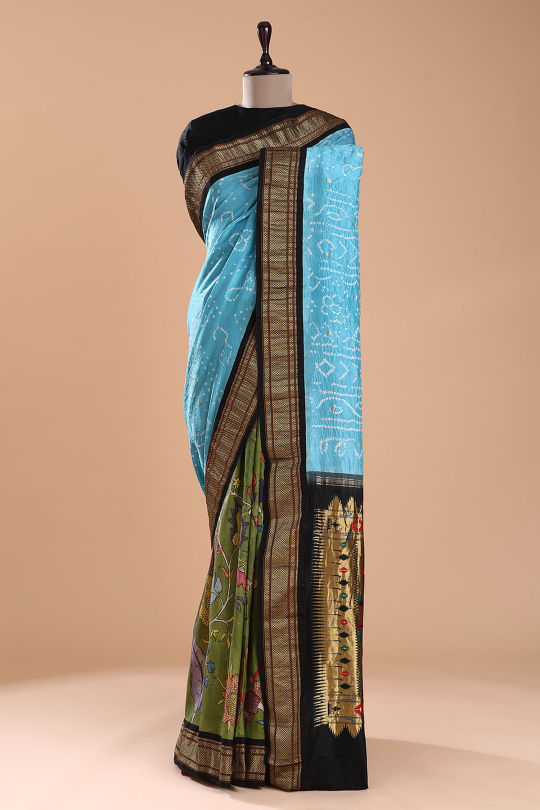
Occasion-Specific Designs: Consider the nature of the festive occasion. chanderi kalamkari sarees come in a variety of designs, from intricate mythological depictions to floral and geometric patterns. Choose a design that complements the celebratory atmosphere.
Color Palette: Opt for colors that resonate with the festive spirit. Bright and vibrant hues like red, royal blue, emerald green, and mustard yellow are popular choices for festive Kalamkari Sarees. However, softer pastel shades can also be chosen for a more subtle look.
Fabric Choice: kalamkari sarees latest designs are crafted in various fabrics, including silk, cotton, and more. For a grand festive appearance, silk Kalamkari Sarees with intricate designs and a lustrous finish are an excellent choice. Cotton Kalamkari Sarees offer a more casual yet elegant look.
Border and Pallu Details: Pay attention to the border and pallu details. hand painted Kalamkari sarees often feature elaborate borders with zari work, beads, or sequins. A well-designed pallu adds a touch of sophistication to the overall look.
Blouse Selection: Coordinate the blouse with the saree, either choosing a matching color or a contrasting one based on the Sarees palette. Consider a heavily embroidered or embellished blouse for an added festive touch.

How to Wear a Kalamkari Saree
Draping Style: To elevate your Kalamkari silk saree for special occasions, consider the draping style. The classic Nivi drape or the flowing Bengali pleats with a shoulder pallu can truly transform your look into one of festive elegance.
Accessorizing: Choose traditional jewelry to complement the Luxurious Kalamkari silk sarees. Gold or antique jewelry works well, such as statement necklaces, jhumkas, and bangles. A bindi and matching footwear complete the festive ensemble.
Hairstyle: Opt for a hairstyle that complements the overall look. Classic bun adorned with flowers or loose curls can enhance the festive appeal. Consider adding traditional hair accessories for an extra touch.
Makeup: Keep the makeup in tune with the festive vibe. Bold lip colors, well-defined eyes, and a subtle blush can enhance the overall appearance. Ensure that the makeup complements the chosen color palette of the saree.
Confidence and Comfort: Ultimately, the key to carrying a Festive Pure Silk Pen Kalamkari Saree is confidence and comfort. Ensure that you feel at ease in your chosen attire, allowing your personality to shine through.
Frequently Asked Questions (FAQs)
What is the significance of Kalamkari Sarees at Samyakk? A: At Samyakk, Kalamkari Sarees hold cultural significance, representing a blend of traditional artistry and modern elegance. Each saree tells a unique story through hand-painted designs, showcasing the rich heritage of Indian craftsmanship.
Do the Kalamkari Sarees at Samyakk feature specific regional styles? A: Samyakk curates Kalamkari Sarees with influences from both Srikalahasti and Machilipatnam styles, ensuring a diverse selection that captures the essence of different regional techniques and patterns.
How can customers care for their Kalamkari Sarees purchased from Samyakk? A: Samyakk recommends gentle care for Kalamkari Sarees, including dry cleaning or hand washing with mild detergent. Avoiding direct sunlight and storing the saree in a cool, dry place helps preserve the vibrancy of the colors and the integrity of the fabric.
Can customers visit Samyakk's Bangalore store to explore Kalamkari Sarees in person? A: Absolutely! Samyakk welcomes customers to explore the charm of Kalamkari Sarees in person at our Bangalore store. The experienced staff is ready to assist in finding the perfect Kalamkari saree that suits individual preferences and occasions.
Conclusion
Kalamkari Sarees stand as a timeless embodiment of India's rich cultural heritage and artistic finesse. With intricate pen work, these Sarees showcase a harmonious blend of tradition and contemporary allure. From luxurious silk to handloom cotton, each piece narrates a unique story through vibrant patterns and captivating designs. The historical significance and cultural relevance of Kalamkari add an extra layer of charm to these garments. As fashion evolves, the enduring appeal of Kalamkari Sarees persists, making them a cherished choice for those who appreciate the beauty of handcrafted elegance and the artistic legacy woven into every thread. To explore and shop exquisite Kalamkari Sarees, visit www.samyakk.com or experience the allure in person at our store in Bangalore. Elevate your style with the artistry of Kalamkari.
#kalamkari silk sarees#silk kalamkari fabric#kalamkari cotton sarees#pen kalamkari sarees#kalamkari pattu sarees#printed pure silk sarees#kalamkari sarees online#handloom cotton sarees with kalamkari blouse#kalamkari pattu sarees with price#designer kalamkari sarees#original kalamkari saree#latest kalamkari sarees#kalamkari blouse with saree#Saree#Sarees#Sari#Sadi#Kalamkari saree designs#Buy kalamkari saree online#Kalamkari saree history#Designer Kalamkari sarees with price#Kalamkari Silk sarees with price#Kalamkari Sarees with kanchi border#Samyakk Saree#Samyakk Collection#Samyakk Clothing
0 notes
Text
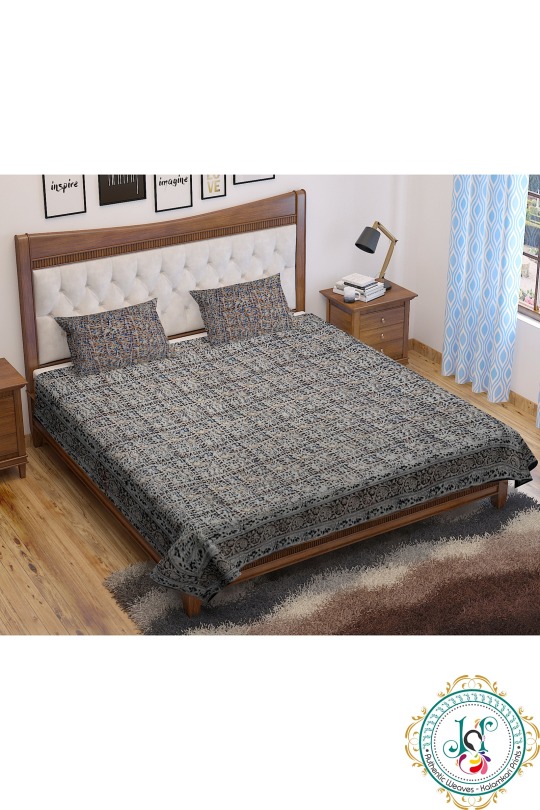
Best online shop for kalamkari and handloom sarees: JSPhandlooms
0 notes
Text
Kalamkari Material: The Artistry of Hand-Painted Fabrics
Kalamkari material is a testament to the age-old tradition of hand-painted textiles that has thrived in India for centuries. The word "Kalamkari" is derived from "kalam," meaning pen or brush, and "kari," which means workmanship. This intricate art form involves the use of natural dyes and skilled craftsmanship to create stunning motifs and designs on fabric.
At The Indian Ethnic Co., we celebrate the rich heritage of Kalamkari by offering a diverse range of Kalamkari materials that showcase the beauty of this ancient craft. Each piece of Kalamkari material is a canvas of artistry, with elaborate hand-painted designs that reflect the cultural and historical significance of this textile tradition.
Kalamkari material is characterized by its intricate patterns, which often depict scenes from Indian mythology, nature, and everyday life. The process involves multiple stages of dyeing and painting, with skilled artisans using fine brushes to create detailed and vibrant designs. The result is a fabric that is not only visually captivating but also a testament to the dedication of the artisans who create it.
Whether you're looking to create bespoke clothing, home decor, or accessories, Kalamkari material adds a touch of art and tradition to your creations. It is a symbol of India's rich textile heritage and the enduring legacy of handmade craftsmanship.
Explore our Kalamkari material collection and immerse yourself in the world of hand-painted fabrics that tell stories, capture culture, and bring a touch of timeless elegance to your projects. Each piece of Kalamkari material is a work of art waiting to be transformed into your own masterpiece.
#kalamkari material#kalamkari fabric online#kalamkari print fabric#kalamkari silk fabric#kalamkari cotton fabric#original kalamkari fabric#kalamkari material online#kalamkari cloth material#kalamkari material for kurti#hand painted kalamkari fabric
0 notes
Text

Wrap yourself in the beauty of tradition with Kalamkari fabrics Online. Each piece is a canvas of intricate motifs and rich history, perfect for the contemporary fashion connoisseur. Explore a collection that weaves together culture and style. Experience the magic of Kalamkari on soft cotton canvases. From delicate florals to intricate scenes, these fabrics encapsulate the essence of art and fashion.
0 notes
Text
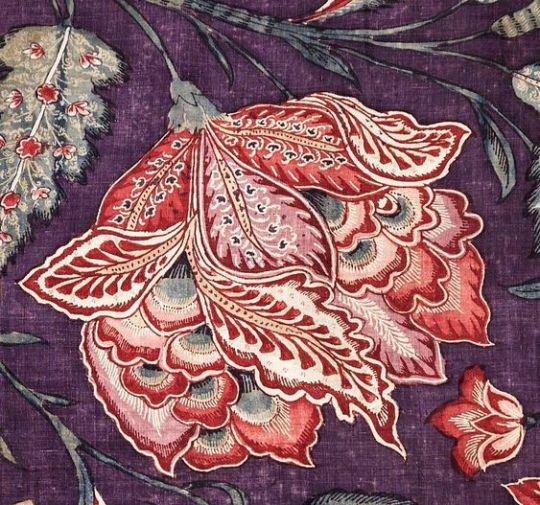
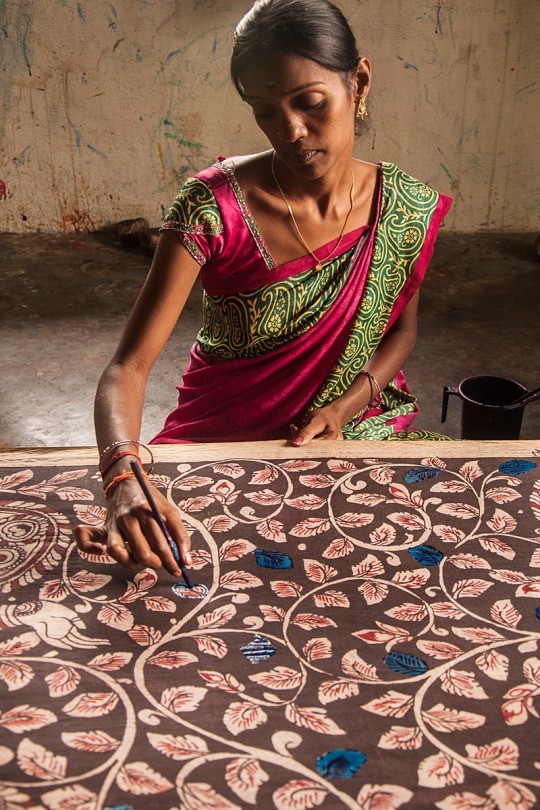
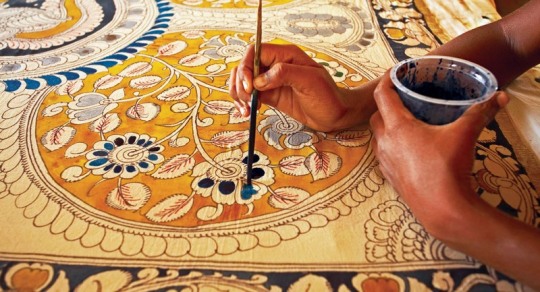
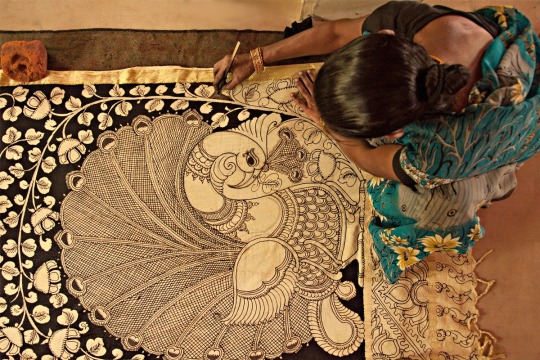
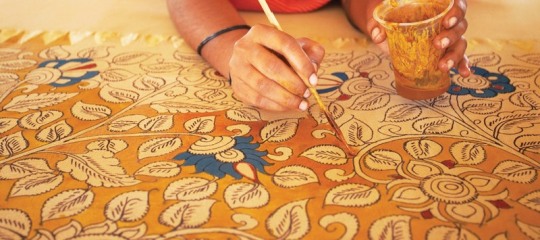
Kalamkari textiles of India.
The Persian name Kalamkari or ‘qalamkari’ is derived from the words kalam (pen) and kari (craftmanship) which translates into drawing using a pen. While there is a mention of these fabrics in ancient scriptures, this art received great patronage during the 16th-17th centurywhen the Golconda Sultanate ruled the Deccan. These wealthy sultans supported this craft and so did the Mughals who were their successors. It was also popular with the British who used these textiles for decorative purposes. Influenced by the Persian school of art, Kalamkari is being practiced for centuries in Andhra Pradesh and the artisans who practiced this art were known as ‘qalamkars’.
The entire process of manufacture is complex and involves as many as 17 steps with multiple rounds of dyeing, washing and boiling the fabric. The initial fabric is sourced from various places like Coimbatore, Erode and Tirupur in Tamil Nadu which is first washed thoroughly to remove any impurities in the form of grease, wax and dirt.
93 notes
·
View notes
Text

The internet has never left a stone unturned when announcing/ showing to the world how bad of a country India is.
But what about the beatiful parts of my country that are hidden from the world and what about the customs and concepts they'll never see and know?
The image above is a fabric shop, you'll find it in every city and every state of India. The prints vary according to the region but now you can get Rajasthani block prints in every nook and corner of India or Kalamkari which originated in Andhra Pradesh but is worn throughout the country.
Everytime I step into a shop like this, I'm boggled with the array of neatly arranged fabrics grading from darker to lighter shades. The sales people in the shops are also so cooperative and actually help you pick out the best fabric.
To all the people on Tumblr that are not from India, if you guys ever visit India, make sure you step into a fabric shop for once and it will be a visually satisfactory experience.
I'll keep posting things these little things from India that make my country fascinating.
Fellow desi Tumblrs, y'all can join in this series too! If you do post, make sure to tag me!
Jai Hind🇮🇳
39 notes
·
View notes
Text
Why Hand-Painted Dupattas Are a Must-Have in Your Wardrobe

The Uniqueness of Hand-Painted Dupattas
1: What is a Hand-Painted Dupatta?
A hand painted dupatta is more than just a piece of fabric; it’s a canvas of art. Traditionally worn by women in South Asia, these dupattas are adorned with unique designs created by skilled artisans. Unlike mass-produced fabrics, which often lack personality, hand-painted dupattas showcase the individual artist’s touch.
When you compare machine-printed fabrics to hand-painted ones, the difference is striking. Machine prints can often feel generic, while hand-painted designs are infused with creativity and craftsmanship. In today’s fast-fashion world, where trends come and go, hand-painted dupattas stand out for their timeless beauty and authenticity. They remind us of the value of handcrafted designs, inviting us to slow down and appreciate true artistry.
2: Why Hand-Painted Dupattas Are Special
What makes hand-painted dupattas so special? It’s the personal touch that goes into creating each piece. The craftsmanship behind each dupatta ensures that no two are alike, guaranteeing a unique addition to your wardrobe. When you wear a hand-painted dupatta, you’re not just wearing a fashion accessory; you’re wearing a story that reflects the artisan’s passion and skill. This unique charm elevates any outfit, making it truly one of a kind.
3: Traditional Art Techniques in Hand-Painting
Hand-painted textiles have deep roots in various cultures, especially in countries like India and Nepal. Techniques such as Madhubani, Pattachitra, and Kalamkari showcase the rich traditions of hand-painting. Each method has its own unique characteristics and stories, adding layers of cultural significance to the dupatta.
Modern innovations in hand-painted textile art have expanded these traditional techniques, blending them with contemporary styles. The result? A beautiful fusion of the past and present, perfect for today’s fashionistas.
4: Benefits of Owning Hand-Painted Dupattas
Investing in a hand-painted dupatta for women is a decision you won’t regret. For starters, these pieces are timeless. Unlike fleeting fashion trends, hand-painted dupattas never go out of style. They can effortlessly transform an ordinary outfit into something extraordinary, adding a splash of color and creativity.
Moreover, high-quality fabric and paint are used, ensuring that your dupatta lasts for years to come. With proper care, these vibrant pieces can remain stunning and fresh, making them a valuable addition to your wardrobe.
5: Versatility: Styling Hand-Painted Dupattas
One of the best features of hand-painted dupattas is their versatility. Whether you’re dressing up for a wedding or looking for a chic accessory for everyday wear, there’s a way to style a dupatta for women for every occasion. Pair them with traditional outfits like kurtis and sarees, or even add them to western attire for a fusion look.
For casual outings, you can throw on a hand-painted dupatta over a simple outfit to create an effortlessly stylish appearance. And for festive events, the vibrant colors and intricate designs will ensure you stand out. With just a few styling tips, you can make your hand-painted dupatta the star of your ensemble!
The Cultural and Sustainable Impact of Hand-Painted Dupattas
6: Supporting Local Artisans and Traditional Craftsmanship
By choosing a hand-painted dupatta, you’re supporting local artisans and promoting traditional craftsmanship. Each purchase helps sustain artisan communities, allowing them to continue their time-honored practices. In an era where ethical fashion is gaining importance, hand-painted items offer a way to contribute to sustainable livelihoods and preserve cultural heritage.
Additionally, as modern fashion trends embrace these beautiful pieces, traditional crafts are experiencing a revival. This means that not only do you get a stunning piece of art to wear, but you also play a role in preserving history.
7: The Environmental Benefits of Hand-Painted Dupattas
When it comes to environmental impact, hand-painted dupattas shine brightly. Compared to machine-made textiles, they often have a lower carbon footprint. The slow fashion movement emphasizes quality over quantity, and hand-painted items align perfectly with this philosophy.
Moreover, many artisans use eco-friendly dyes and sustainable fabrics, making these dupattas not just beautiful but also kind to the planet. By choosing a hand-painted dupatta, you’re making a conscious choice for both your wardrobe and the environment.
8: Hand-Painted Dupattas as Art Pieces
Owning a hand-painted dupatta is like possessing a piece of art. Each design reflects the artist’s creativity and talent, allowing fashion to double as a form of art appreciation. Many dupattas draw inspiration from famous art movements or renowned pieces, making them unique treasures in your wardrobe.
9: The Timeless Appeal of Hand-Painted Dupattas
Hand-painted dupattas are not just trendy items; they are heirloom pieces meant to be passed down through generations. Their timelessness stands in stark contrast to the fast-fashion trends that often fade away. Fashion enthusiasts and art lovers alike see these dupattas as collectible items, celebrating the fusion of fashion and art.
10: How to Care for Hand-Painted Dupattas
To keep your hand-painted dupatta looking vibrant and fresh, it’s essential to care for it properly. Hand wash your dupatta in cold water with mild detergent, avoiding harsh chemicals. Store it in a cool, dry place away from direct sunlight to prevent fading. By following these best practices, you can maintain the beauty and integrity of your paintings apparel for years to come.
11: Where to Buy Hand-Painted Dupattas
If you’re eager to add a hand-painted dupatta for women to your wardrobe, look for reputable online stores or artisan markets like Palette Vibes. Ensure that you consider factors like authenticity, materials, and craftsmanship. Shopping from trusted sources, such as Palette Vibes, not only guarantees quality but also supports the artisans who create these beautiful pieces.
Conclusion
hand-painted dupattas are a must-have for anyone looking to enrich their wardrobe with unique, versatile, and culturally significant pieces. These stunning dupattas, created by hearing-impaired artists supported by Creative People NGO and promoted globally by Palette Vibes, bring a special touch to any outfit. Not only do they showcase beautiful artistry, but they also promote sustainability and support talented artisans. So, embrace the vibrant world of hand-painted dupattas, and experience the beauty, craftsmanship, and meaningful impact they bring to your wardrobe!
youtube
Crafted by Indian Artists for the World
Palette Vibes collaborates with artists across India to bring their creative visions to life. These artists, who specialize in intricate watercolor and acrylic paintings, pour their heart into each piece, which is then digitized for a seamless transfer onto our dupattas. By wearing one of our dupatta for women, you not only add elegance to your wardrobe but also support the Indian artist community, helping them gain global recognition.
Supporting Specially Abled Artists
Our mission goes beyond fashion. We are proud to work with non-profit organizations to uplift specially abled artists. These talented individuals have a unique perspective on the world, and their artwork is nothing short of extraordinary. With every purchase, you contribute to providing them a sustainable income, empowering them to live with dignity and independence.
Join Our Movement
Palette Vibes invites you to join our mission to support Indian artists and showcase their exceptional craftsmanship on a global platform. Every hand painted dupatta you purchase contributes to this vision of artistic empowerment, cultural preservation, and creative collaboration.
FAQ 1: What makes hand-painted dupattas different from printed ones?
Ans: Hand-painted dupattas are crafted by skilled artisans, with each piece being unique due to the manual painting process. Printed dupattas are mass-produced and lack the personal touch and intricate detailing found in hand-painted versions.
2: How do I style a hand-painted dupatta? Ans: Hand-painted dupattas can be styled with both traditional outfits like sarees and kurtis, and modern outfits such as dresses or tunics. The key is to let the dupatta be the highlight by keeping the rest of the outfit simple.
3: Are hand-painted dupattas durable? Ans: Yes, they are quite durable, especially if made with high-quality materials and eco-friendly paints. Proper care, such as gentle washing and careful storage, will ensure they last for years.
4: Are hand-painted dupattas sustainable? Ans: Hand-painted dupattas are more sustainable than mass-produced textiles because they often use natural dyes and are made in small batches by artisans, contributing to slow fashion.
5: Where can I buy authentic hand-painted dupattas? Ans: You can find authentic hand-painted dupattas from artisan markets, online platforms supporting traditional crafts, or boutique stores that specialize in handcrafted fashion. or you can find in Palette Vibes website
#Palette Vibes#Indian Art#Indian clothing#Dupatta#Hand Painted Dupatta#Fashion#indian fashion#Trending Fashion#Creative People#Youtube
2 notes
·
View notes
Text
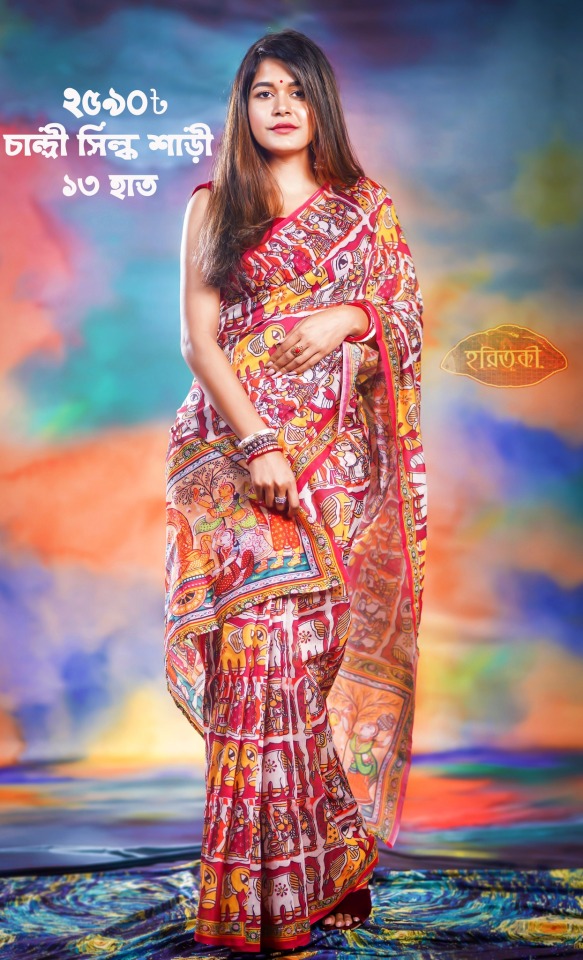
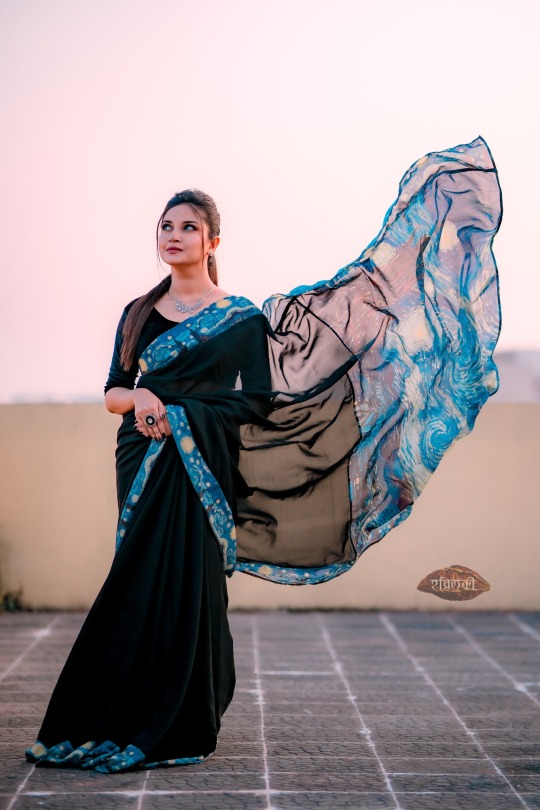
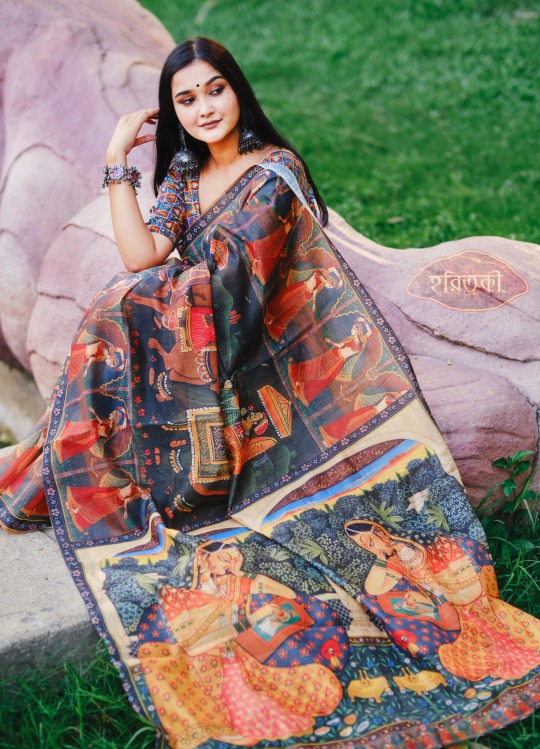
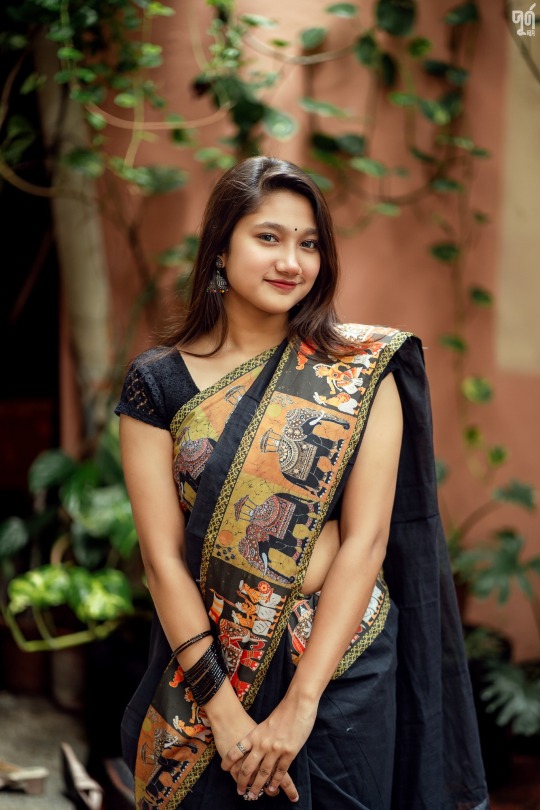
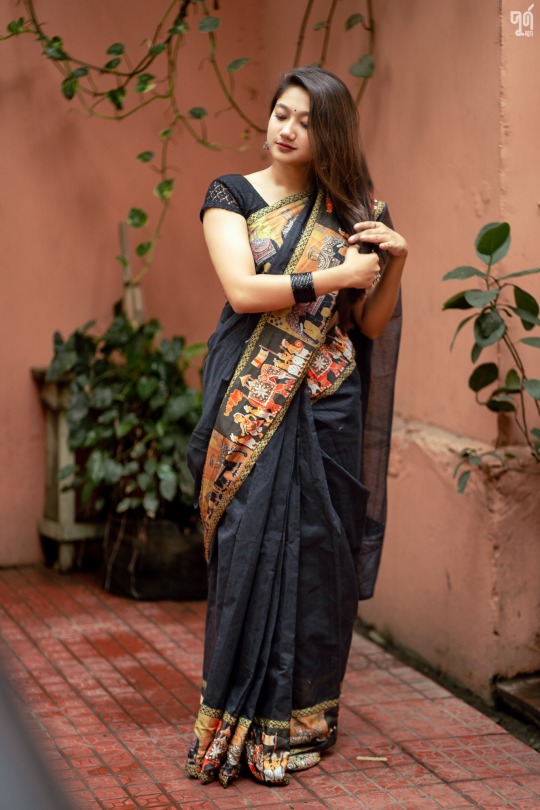
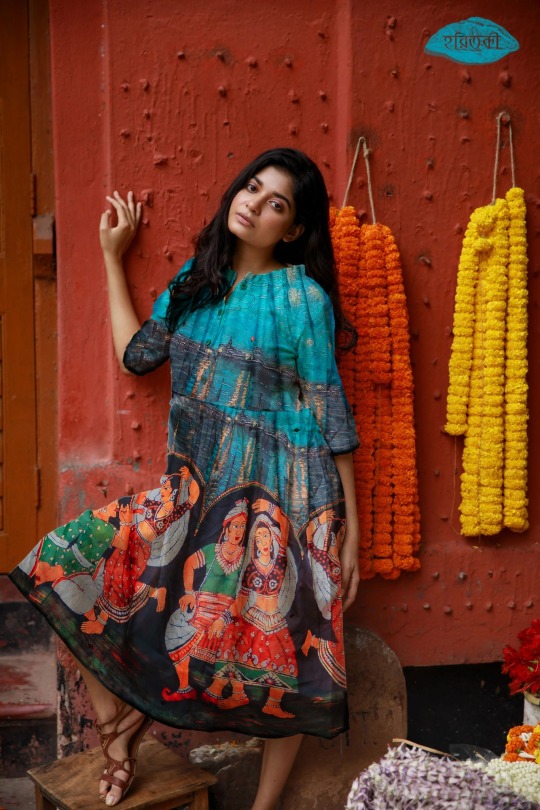
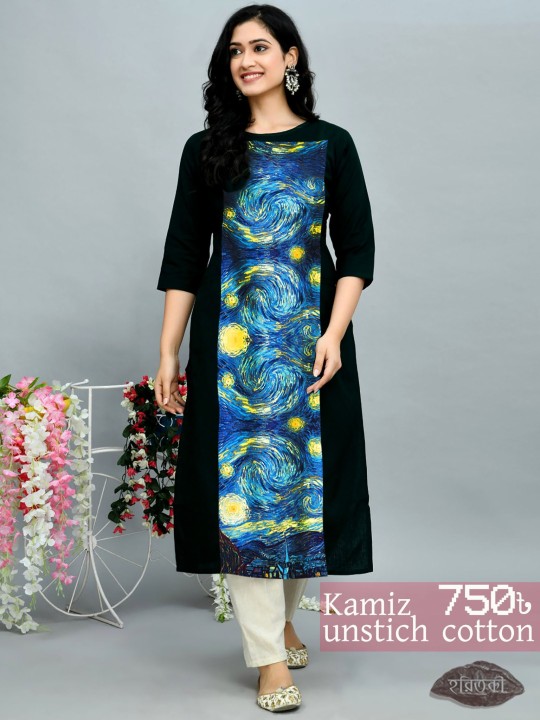
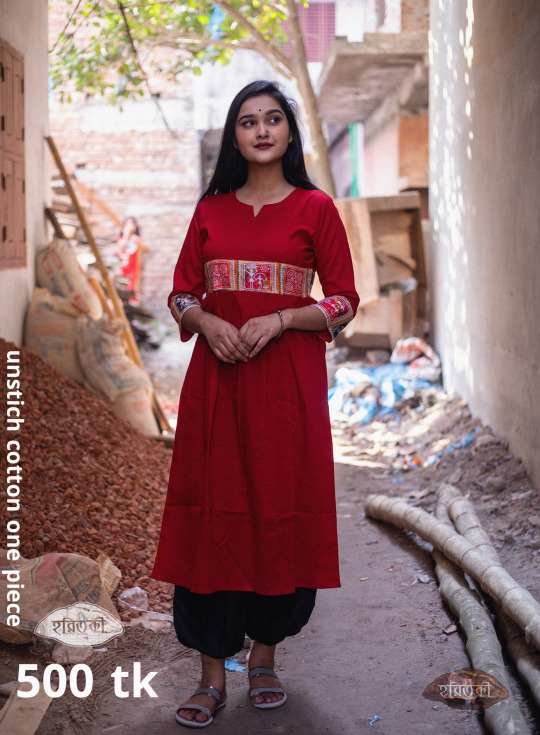
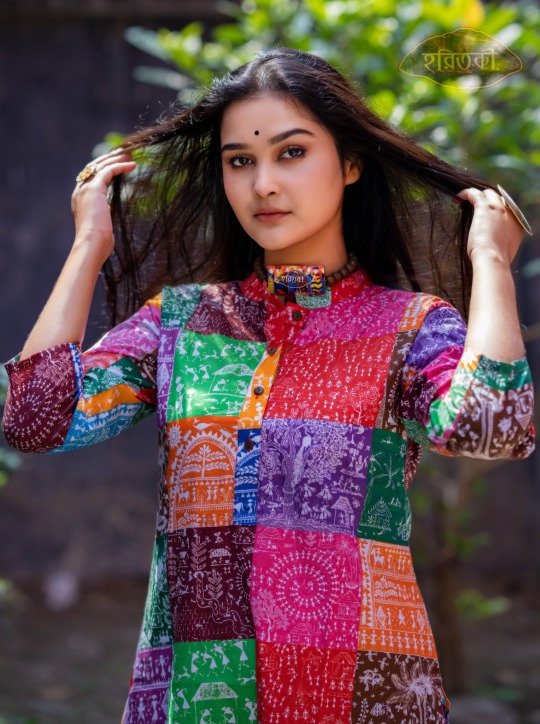

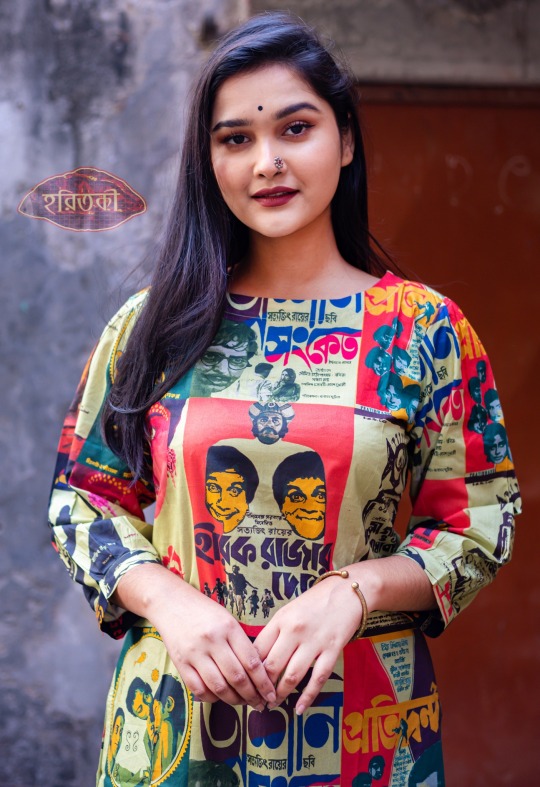
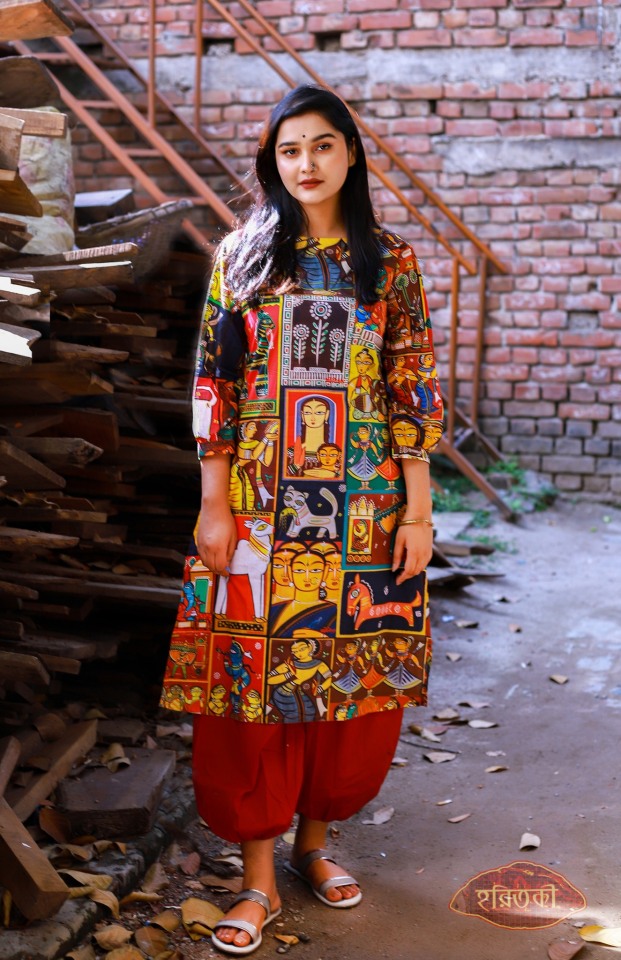
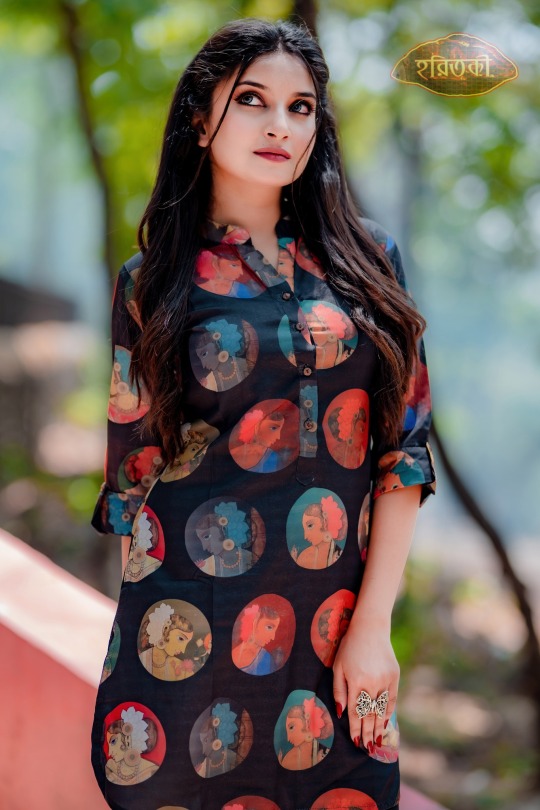
Horitoki Women Saree Collection
https://horitoki.com
Horitoki Women Saree Collection Horitoki is a popular brand for traditional women's clothing in Bangladesh. They offer a wide range of sarees, blouses, kurtis, dresses, dupattas, and panjabis. Their saree collection is particularly noteworthy, with a range of fabrics and designs to choose from.
Some of the popular sarees offered by Horitoki include:
Van Gogh's Starry Night Saree: This saree is made from mixed silk and features a print inspired by Vincent Van Gogh's famous painting, "Starry Night."
Dhakai Rickshaw Paint Saree: This saree is also made from mixed silk and features a print inspired by the colorful rickshaws of Dhaka.
Kalamkari Art Saree: This saree is made from mixed silk and features a beautiful Kalamkari print.
In addition to these, Horitoki offers a range of other sarees in different fabrics such as cotton, silk, and mixed silk. They also have a range of saree blouses and fabrics that can be used to create custom blouses.
You can shop for Horitoki's saree collection online at their website horitoki.com.bd.
https://horitoki.com
#saree#sareelove#sareeindia#sareefashion#sareecollection#kiara advani#indian#bollywood#singer#hunter schafer#fashion#style#fashion photography#high fashion#dress#dresses#wedding dress#blue dress#white dress#yellow dress#black dress#purple dress
6 notes
·
View notes
Text
Kalamkari Fabric Online - Discover Artistic Creations at Itokri
Discover the exquisite charm of Kalamkari fabric online at Itokri, where traditional craftsmanship meets contemporary elegance. Our collection showcases a diverse range of handcrafted Kalamkari fabrics, renowned for their intricate designs and rich cultural heritage. Each piece is meticulously crafted by skilled artisans, employing traditional techniques such as hand-painting and block-printing to create stunning motifs and vibrant colors. Whether you're looking to fashion unique apparel, create stunning home decor, or find distinctive gifts, Itokri offers a curated selection that embodies the timeless beauty of Kalamkari artistry. Explore our online store and bring home the allure of Kalamkari fabric, celebrated for its artistic excellence and cultural significance.
1 note
·
View note
Text
Warli Paintings: Exotic form of simple art
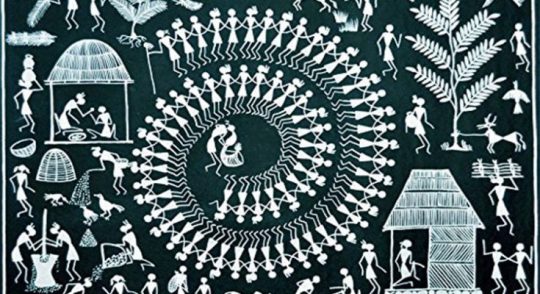
A Picture is a ballad without words. The Warli Art shape is the pictorial dialect used to speak to the tribal people craft of the early tribes of Thane area, Maharashtra.
It portrays the dancing, chasing and development of land with the tribal hovels made in a dark, mustard yellow or the white foundation. Keeping in mind the end goal to educate these structures to the understudies, we embrace a particular showing strategy, so that even non-craftsmen can paint the lovely warli. All these and more can be investigated about the antiquated India.
The word “Warli” originates from “warla” which implies a real estate parcel or a field despite being in such closeness of the biggest city in India, Warli tribesmen are as yet not urban. Warli Art was first found in the mid-seventies. While there are no records of the correct beginnings of this workmanship, its underlying foundations might be followed to as right on time as the tenth century AD. Warli is the distinctive articulation of day by day and get-togethers of the Warli tribe of Maharashtra, utilized by them to enhance the dividers of town houses. This was the main method for transmitting fables to other people who are not familiar with the composed word.
These works of art don’t portray fanciful characters or pictures of divinities, however delineate social life. Pictures of individuals and creatures, alongside scenes from everyday life are made in a free cadenced example. Painted white on mud dividers, they are entirely near pre-notable buckle artistic creations in execution and as a rule delineate scenes of human figures occupied with exercises like chasing, dancing, sowing ,collecting, going out, drawing water from well, drying clothes.
It fundamentally comprises of geometrical examples
1. Circle: speaking to the sun and the moon
2. Triangle: triangle got from mountains and pointed trees
3.Square: showing a consecrated walled area or a land parcel. So the focal rationale in every custom painting is the square
These geometric figures are consolidated to shape lovely examples .Like two summits of triangles are combined to frame a human figure.
Warli canvases on paper have turned out to be exceptionally prevalent and are presently sold all over India. Today, little compositions are done on fabric and paper however they look best on the w alls or as colossal wall paintings that draw out the tremendous and otherworldly universe of the Warlis. For the Warlis, convention is still clung to however in the meantime new thoughts have been permitted to leak in which encourages them to confront new difficulties from the market.
Learn this simple art, find designs & explore the world of warlis at Penkraft through our workshop.
Penkraft conducts classes, course, online courses, live courses, workshops, teachers’ training & online teachers’ training in Handwriting Improvement, Calligraphy, Abacus Maths, Vedic Maths, Phonics and various Craft & Artforms — Madhubani, Mandala, Warli, Gond, Lippan Art, Kalighat, Kalamkari, Pichwai, Cheriyal, Kerala Mural, Pattachitra, Tanjore Painting, One Stroke Painting, Decoupage, Image Transfer, Resin Art, Fluid Art, Alcohol Ink Art, Pop Art, Knife Painting, Scandinavian Art, Water Colors, Coffee Painting, Pencil Shading, Resin Art Advanced etc. at pan-India locations. With our mission to inspire, educate, empower & uplift people through our endeavours, we have trained & operationally supported (and continue to support) 1500+ home-makers to become Penkraft Certified Teachers? in various disciplines.
5 notes
·
View notes
Text
The Fascinating World of Kalamkari Art: A Journey Through Tradition and Creativity
Kalamkari art is an age-old Indian tradition that has captivated the hearts and minds of art lovers around the world. Known for its intricate designs and vivid storytelling, this beautiful form of art represents a rich cultural heritage. In this article, we will delve deep into the origins of Kalamkari, its significance, and why it has continued to thrive in the modern world. If you're interested in learning Kalamkari art, especially in a dynamic city like Delhi, we will also explore Kalamkari Art workshops available for aspiring artists.

What is Kalamkari Art?
Kalamkari is a traditional Indian art form known for its intricate, hand-drawn designs, often depicting mythological figures, religious symbols, and nature-inspired elements. The word "Kalamkari" comes from two Persian words: "kalam," meaning pen, and "kari," meaning work or craftsmanship. Thus, Kalamkari literally means "pen work."
This art is characterized by fine lines, vibrant colors, and a storytelling approach that connects deeply with India's rich cultural heritage. Initially done on fabrics, this form of art is now also seen on paper and other materials.
The History and Origin of Kalamkari Art
2.1 Early Beginnings in Ancient India
Kalamkari art has roots in ancient India, dating back over 3,000 years. It is believed that the art form originated in the southern part of India, particularly in Andhra Pradesh and Telangana, where it was traditionally used to decorate temples, fabrics, and even walls. This form of expression was often associated with religious rituals and festivals, with intricate patterns and images created to honor gods and goddesses.
2.2 Kalamkari in Mythology and Religion
One of the most fascinating aspects of Kalamkari Art is its strong connection with Hindu mythology and religion. Many of the designs feature scenes from popular epics like the Mahabharata and Ramayana. Depictions of gods like Lord Krishna, Lord Shiva, and Goddess Durga are common, with artists weaving stories through their detailed illustrations.
The use of this art was not limited to temples alone. Kalamkari was also employed to make textiles that were used by priests, royal families, and the elite, signifying its cultural importance.
The Different Styles of Kalamkari
3.1 Andhra Pradesh Kalamkari
This style is renowned for its elaborate designs and fine detailing. It is primarily associated with fabric painting, where natural dyes are used to create images of deities, religious scenes, and motifs from nature. Andhra Kalamkari often features a detailed border, making the designs look like exquisite pieces of art meant to tell stories.
3.2 Telangana Kalamkari
Telangana Kalamkari is known for its boldness and use of vibrant colors. Unlike the intricate designs of Andhra Pradesh, Telangana Kalamkari often has simpler patterns but employs a more free-flowing approach. The use of natural dyes, mostly derived from plants and minerals, is a signature of this style.
Materials and Techniques Used in Kalamkari Art
4.1 Tools of the Trade
The primary tool used in Kalamkari is a bamboo pen, which is sharpened to create fine lines and detailed illustrations. Artists dip the pen into natural dyes to draw intricate patterns. Alongside this, a few other tools, such as brushes and natural sponges, are used to fill in colors and create shading effects.
4.2 Natural Dyes and Fabrics
The beauty of Kalamkari lies in its use of natural dyes. Traditionally, artists would use colors extracted from plants, minerals, and even insects. For example, red is made from a plant called madder root, and yellow comes from turmeric. As for the fabric, cotton and silk are the most common materials used in Kalamkari Art due to their ability to absorb the dyes well.
Significance of Kalamkari Art in Indian Culture
Kalamkari art holds immense significance in Indian culture. It is not only a method of artistic expression but also a way to preserve age-old traditions. This art form brings the myths, legends, and history of India to life, allowing generations to connect with their cultural roots. Additionally, Kalamkari has often been used in the context of spiritual practices, with many believing that the art has a deep connection to divine energies.
Kalamkari Art: A Modern Revival
6.1 Integration with Contemporary Designs
While Kalamkari is a traditional art form, it has seen a significant revival in recent years. Artists are increasingly blending Kalamkari designs with contemporary art, creating a fusion of old and new. Modern art movements, such as abstract art, have found a place in Kalamkari, with artists incorporating new techniques and patterns that appeal to younger generations.
6.2 Kalamkari in Fashion and Interior Design
Today, Kalamkari is not just seen in paintings but also in fashion and interior design. Designers use Kalamkari motifs to create stunning garments, such as sarees, dresses, and scarves. The art has also found its way into home décor, with Kalamkari designs adorning cushions, curtains, and wall hangings, making it a popular choice for those seeking a traditional yet contemporary aesthetic.
Why Should You Learn Kalamkari Art?
7.1 Benefits of Practicing Traditional Art
Learning Kalamkari is not only about developing a new skill but also about connecting with a rich cultural heritage. The practice of Kalamkari allows you to explore your creativity and express emotions through art. It is also a mindful practice that helps reduce stress and promotes mental well-being.
7.2 Unleashing Your Creativity
One of the most exciting aspects of Kalamkari Art is that it allows you to work with a variety of materials and create something truly unique. Whether you’re an experienced artist or a complete beginner, learning this art form will help you unlock your creativity, refine your skills, and discover a new passion for traditional Indian art.
Kalamkari Art Workshops in Delhi: A Hub for Artists
8.1 Discovering Rajni Dutta's Kalamkari Art Workshops
Delhi, with its vibrant art scene, is home to many Kalamkari art workshops that offer the perfect opportunity to learn this ancient craft. One such workshop is hosted by Rajni Dutta, an experienced Kalamkari artist who has been teaching traditional art forms for years. Rajni's workshops are designed to give you hands-on experience with Kalamkari techniques, from drawing the initial designs to filling them in with natural dyes.
8.2 What to Expect from a Kalamkari Art Workshop in Delhi
When you attend a Kalamkari workshop in Delhi, expect to learn everything from the basics of sketching and design creation to the intricacies of applying natural dyes. You will also be introduced to different styles of Kalamkari, enabling you to explore the versatility of the art form. These workshops often cater to all skill levels, ensuring that everyone—from beginners to advanced artists—can benefit.
Step-by-Step Guide to Creating Your Own Kalamkari Art
9.1 Choosing the Right Tools
To start with Kalamkari, gather your tools. You’ll need a bamboo pen, a range of natural dyes, a brush, and a piece of fabric or paper. Choosing the right material is essential for achieving the desired result. Cotton fabric is often recommended for beginners because it absorbs the dyes well and allows the colors to show vibrantly.
9.2 Creating Intricate Designs
Begin by sketching your design lightly with a pencil. Once the outline is in place, use your bamboo pen to start adding fine details. Remember, Kalamkari art relies heavily on precision and patience. Take your time to perfect each line and pattern.
9.3 The Final Touch: Bringing Your Art to Life
Once the design is complete, use the natural dyes to fill in the colors. Start with lighter shades and gradually build up to darker hues. Allow the artwork to dry before adding any final touches. When done, your Kalamkari piece will come to life, radiating stories and culture through every stroke.
Kalamkari in the Global Art Scene
Kalamkari art is no longer confined to India. With its growing popularity, artists and art lovers around the world have begun to appreciate its rich history and vibrant designs. From galleries in Europe to fashion shows in New York, Kalamkari is making waves globally. Its traditional yet contemporary appeal has earned it a special place in the world of fine art.
Conclusion
Kalamkari Art is much more than just a form of painting. It is a window into India’s spiritual, cultural, and artistic heritage. Whether you're a budding artist looking to dive into traditional techniques or someone who simply appreciates the beauty of detailed craftsmanship, learning Kalamkari is a rewarding experience. With workshops like those offered by Rajni Dutta in Delhi, you can explore this unique art form and connect with its deep cultural roots.
0 notes
Text
Handwoven & Handcrafted Clothing by The Indian Motif
Though the world is in a modernized era there is always a special audience for retro collections. To grab their attention, Indian Motif offers handwoven & handcrafted clothes. Each piece in the clothes tells a story of artistry, heritage, and the human touch elements which cannot be expressed by the machines. Let’s dive into the detailed guide to uncovering the stories and artistry behind Indian Motif’s handcrafted collections.
Why Handcrafted Clothing Matters
Preserving Cultural Legacy Handcrafted clothing serves as a living archive of India’s diverse textile traditions. Each piece like the Molakalmuru saree from Karnataka or a handblock-printed creation from Bagru tells a story of its origin and the weaves of Karnataka. These weaves are not just fabrics; they are a canvas of regional artistry, reflecting the cultural ethos of their creators.
Sustainability at Its Best In an age of disposable fashion, handcrafted sarees and other clothes champion the principles of slow fashion. The processes involved in creating handwoven sarees or Kaamini handcrafted blouses are eco-friendly, relying on minimal machinery and sustainable materials. By choosing these garments, you contribute to reducing the carbon footprint and promoting ethical practices.
Unmatched Craftsmanship From festive weaves adorned with intricate zari work to understated elegance for daily wear, handcrafted clothing stands out for its meticulous attention to detail. The art of weaving a pure Kanjivaram silk saree or crafting a Bagru handblock-printed mul cotton saree is a labor-intensive process that requires unparalleled skill and patience.
Sarees
Sarees are a symbol of grace and tradition in Indian clothing. Whether it’s a wedding or a festival, sarees are a timeless choice that beautifully combines tradition with modern style.

When it comes to celebrations, The Indian Motif offers an impressive collection of sarees that bring a touch of grandeur and cultural richness to your wardrobe. Among these, the Molakalmuru Sarees are known for their intricate nature-inspired motifs and traditional craftsmanship. The Kanjivaram Silk Sarees boast vibrant colors and exquisite designs, making them a timeless choice. Lastly, the Venkatagiri Silk Sarees exude luxury with their intricate zari work and vibrant hues, perfect for any grand occasion.

When it comes to work wear, The Indian Motif offers a versatile collection of sarees that blend style, comfort, and tradition seamlessly. Among these, the Ikkat Cotton Sarees stand out with their bold patterns and intricate tie-dye technique, offering a perfect balance of elegance and ease. The Weaves of Karnataka showcase handloom sarees like Kodiyala and Udupi Cotton, known for their lightweight feel and intricate designs. For those who love artisanal touches, the Handblock Printed Sarees bring unique patterns and vibrant colors using traditional Bagru printing techniques. These sarees are ideal for creating a professional yet sophisticated look.
Meanwhile, check out our handcrafted silk sarees and handcrafted clothing for women.

The Abhiroop collection from The Indian Motif brings a refined touch to men’s fashion with handwoven and handcrafted shirts that combine tradition with modern style. Each shirt in this collection, from Kalamkari prints to Bagru handblocks, tells a story of artistry, natural dyes, and impeccable craftsmanship. These cotton shirts are designed for comfort and versatility, ideal for both casual and festive occasions.

Enhance your saree ensemble with our stunning blouse collection, combining traditional craftsmanship with modern appeal. The Kanchi Cotton Embroidered Blouse Annam Elegance features intricate embroidery with block print details, offering a sophisticated and cheerful design. The Mangalgiri Cotton Blouse Kanakambaram pairs beautifully with silk sarees, boasting zari borders and Pen Kalamkari patchwork for a refined touch. The Kanchi Cotton Chettinad Kattam Blouse Kattam Kondattam impresses with its chettinad patterns and mirror work, adding a chic, festive element. For a heritage-inspired look, the Konark Love Cotton Blouse draws from Odisha’s iconic motifs, bringing cultural elegance to your outfit. Each blouse is a perfect complement to elevate your saree style.
Wrapping Up
Indian Motif celebrates the beauty of handcrafted clothing, where tradition meets sustainability and artistry. With each piece, you support a rich cultural legacy and embrace unique craftsmanship. Explore our collections today and wear a story of heritage and elegance.
1 note
·
View note